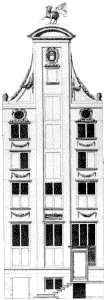Nicolaas van Staphorst

Amsterdam Heritage:
Singel 460
Nicolaas van Staphorst (bapt. 14 January 1742, Amsterdam – bur. 14 June 1801, Amsterdam) was a Dutch banker and a conservative republican. Up till 1794 he was involved in a total of eleven loans that were granted in Amsterdam to the United States with a value of 29 million guilders, and in the Holland Land Company.
Life
In 1782, the brothers led discussions with John Adams over a loan to the United States of five million guilder, at that time a considerable sum. A syndicate was formed to organize the USA's first foreign loan between the Staphorsten, the Willinks and De la Lande & Fijnje. Joan van der Capellen tot den Pol was marked down for 12.000 guilders. Three others loans followed: in 1784, 1787 and 1788. (In 1786 the merchant Daniel Parker took over the shares of De la Lande & Fijnje). Simon Schama noted: "Part of the attraction of this stock was, doubtless, the possiblility of buying cheap and selling at a quick profit to investors less well informed than the brokers as to the state of American credit."
In September 1787 Nicolaas van Staphorst did not flee to northern France like his brother Jacobus, a prominent leader of the Dutch patriots and of the Revolutionary Committee of the Batavian Republic. In the beginning of 1788 Nicolaas proclaimed that "experts" must draw up a new constitution for the moment at which the patriotic revolutions would take place. After the American example, he advised that the seven regions of the Netherlands and the Generality Lands be forced to give up their sovereignty and administrations, to be replaced by a whole new constitution in which the people's influence on the election of the regents would be hugely increased.
The Van Staphorst brothers, along with Wilhelm Willink and Rutger Jan Schimmelpenninck, were in 1789 shareholders in the Holland Land Company, a society that invested in the north of the state of New York, not far from Ontario, Pennsylvania and some canals: the Patowmack Canal, James River and Kanawha Canal and Santee Canal. He supported Gerrit Boon, his brother-in-law, winning maple syrup from the ahorn.
Nicolaas and the secret political societies which were formed were of the opinion that this issue had to be resolved at all costs, and that Johan Valckenaer and his friends were the most appropriate people to draw up a Dutch-language constitution. The leading Dutch patriots, like Wiselius, Krayenhoff, and Nicolaas van Staphorst requested general Charles-François Dumouriez to plant the liberty tree in The Hague or on the Dam square and to bring about liberty, equality and fraternity by force. They also spoke about a new calendar, to make every month of an equal length. At the end of November 1794 he and Alexander Gogel fled to Bremen or Hamburg, because of the discovery of a weapons cache. He was banned from city of Amsterdam. Two months later the French Army had occupied the whole of Holland.
External links
Literature
- Rosendaal, J. (2003) Bataven! Nederlandse vluchtelingen in Frankrijk 1787-1795.
- Schama, S. (1977) Patriots and Liberators: Revolution in the Netherlands, 1780-1813, p. 59, 156, 170,